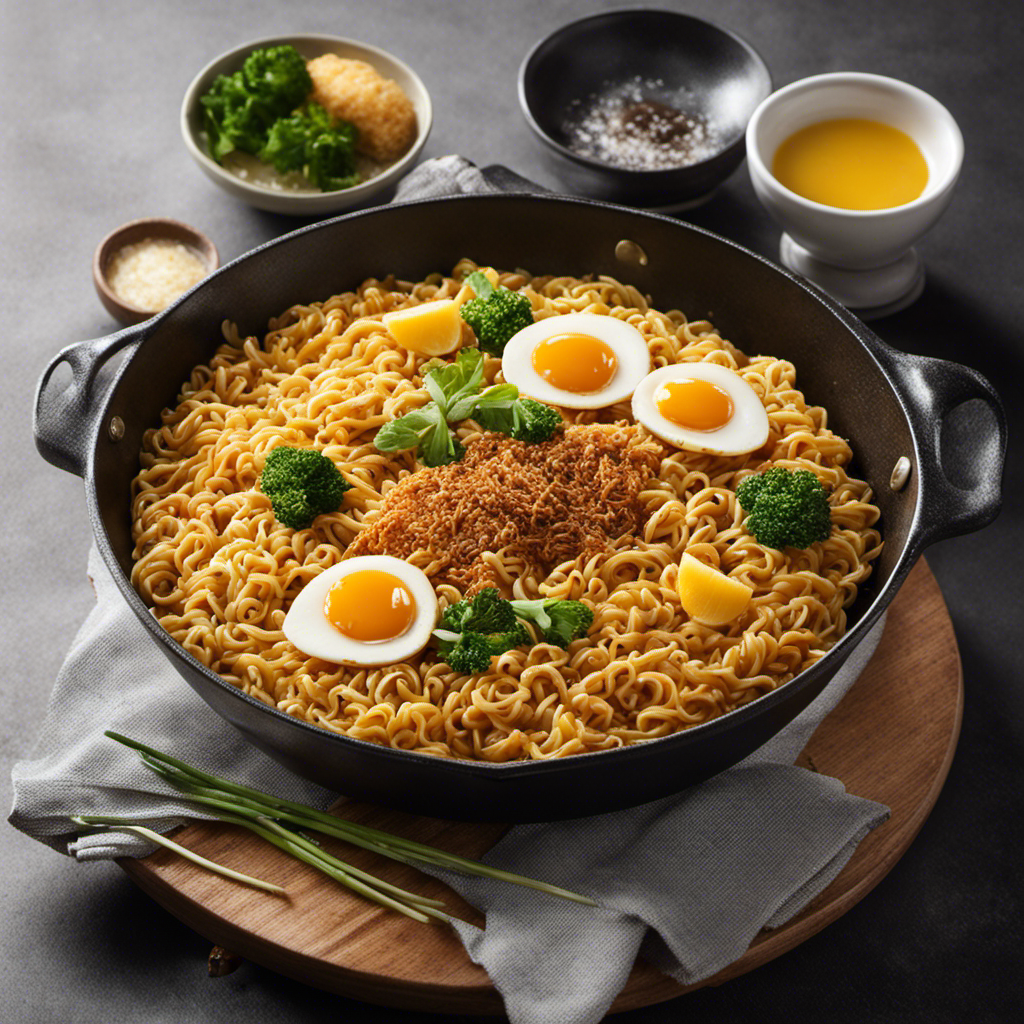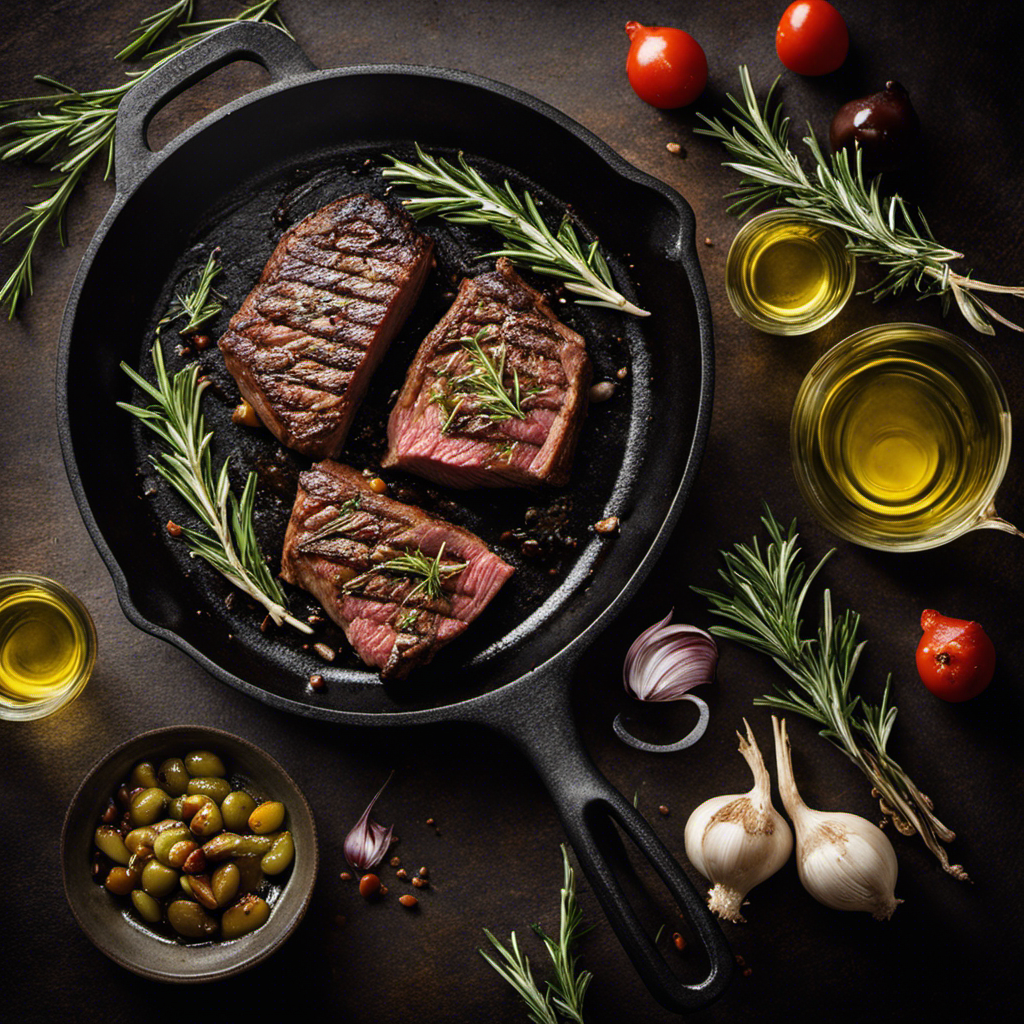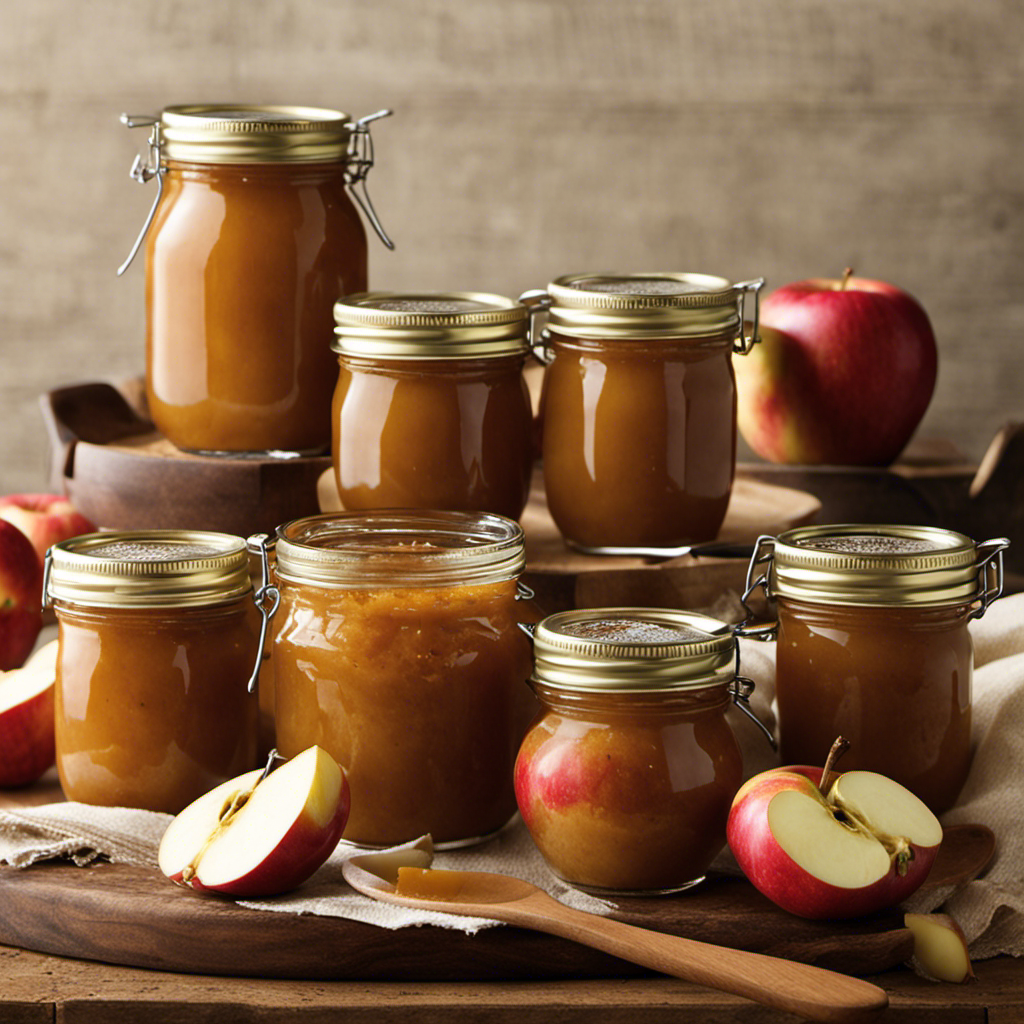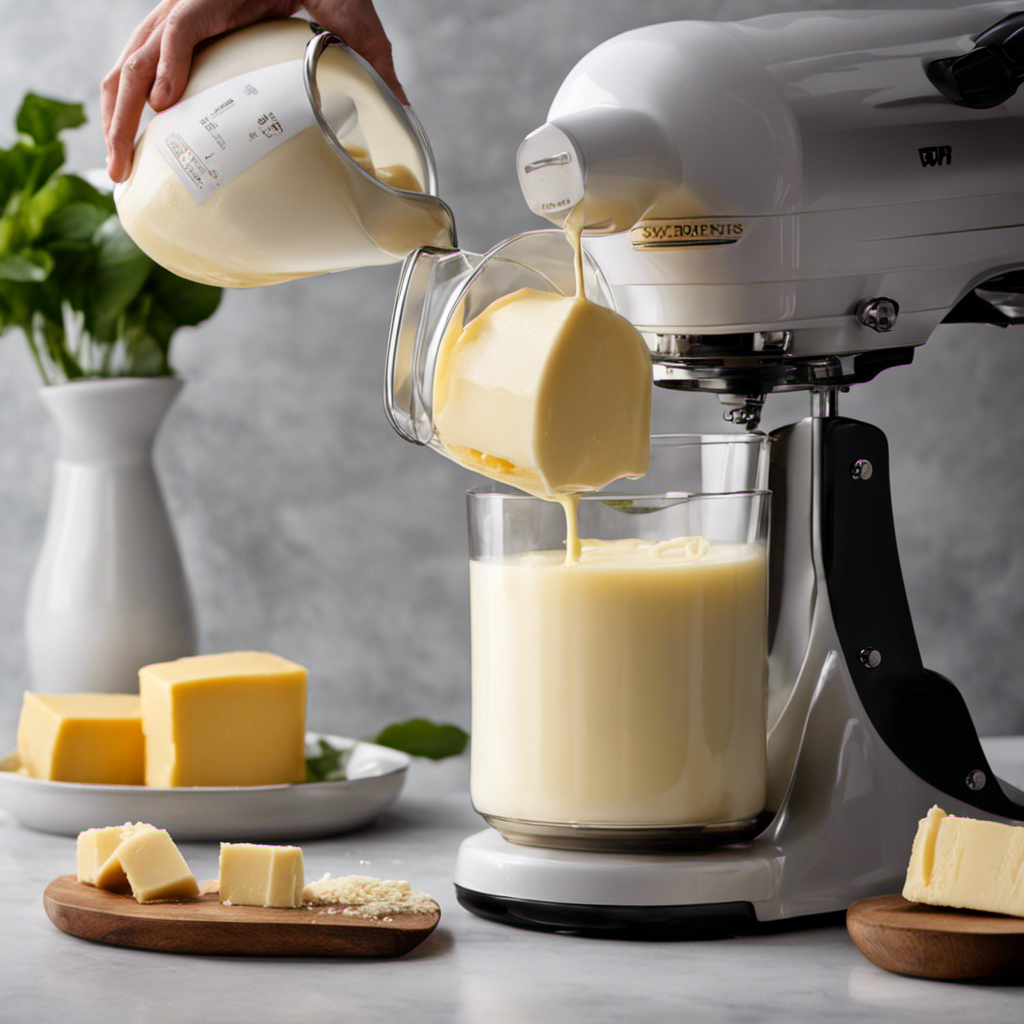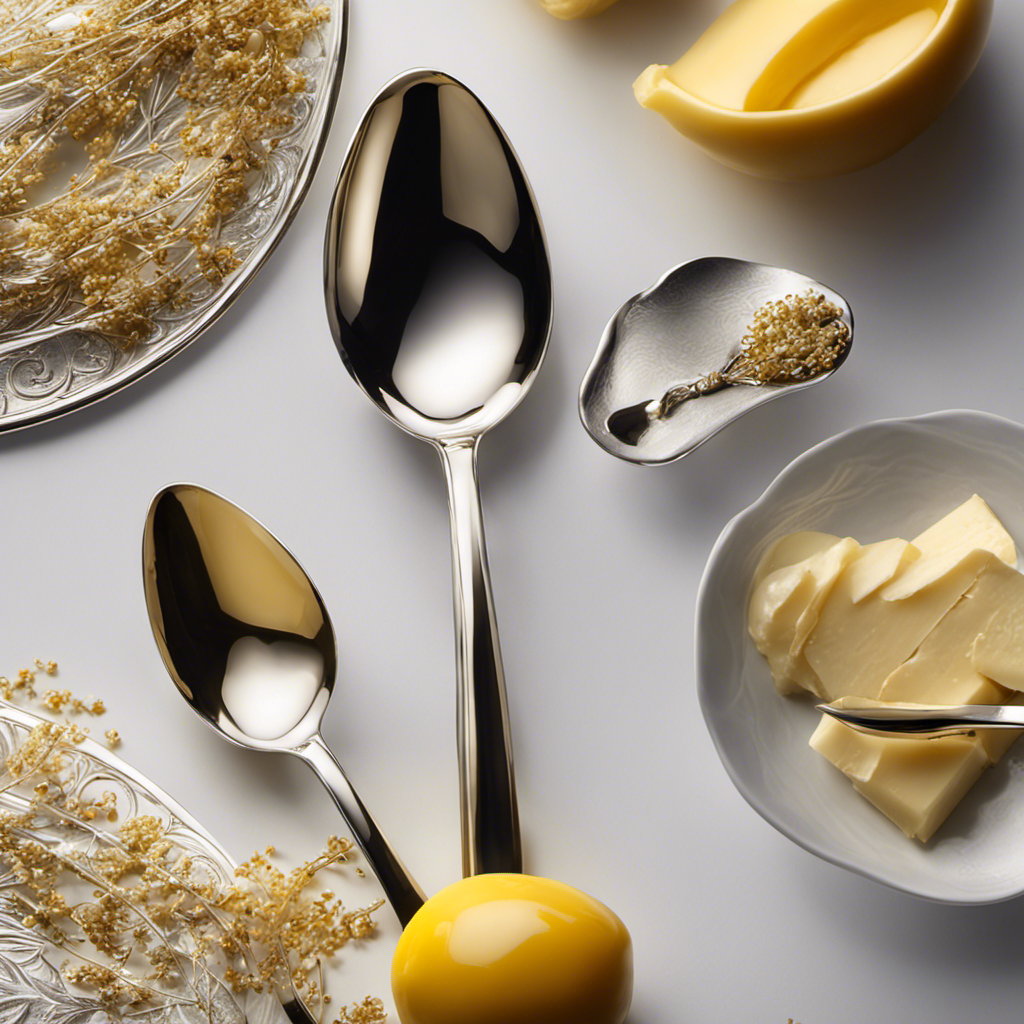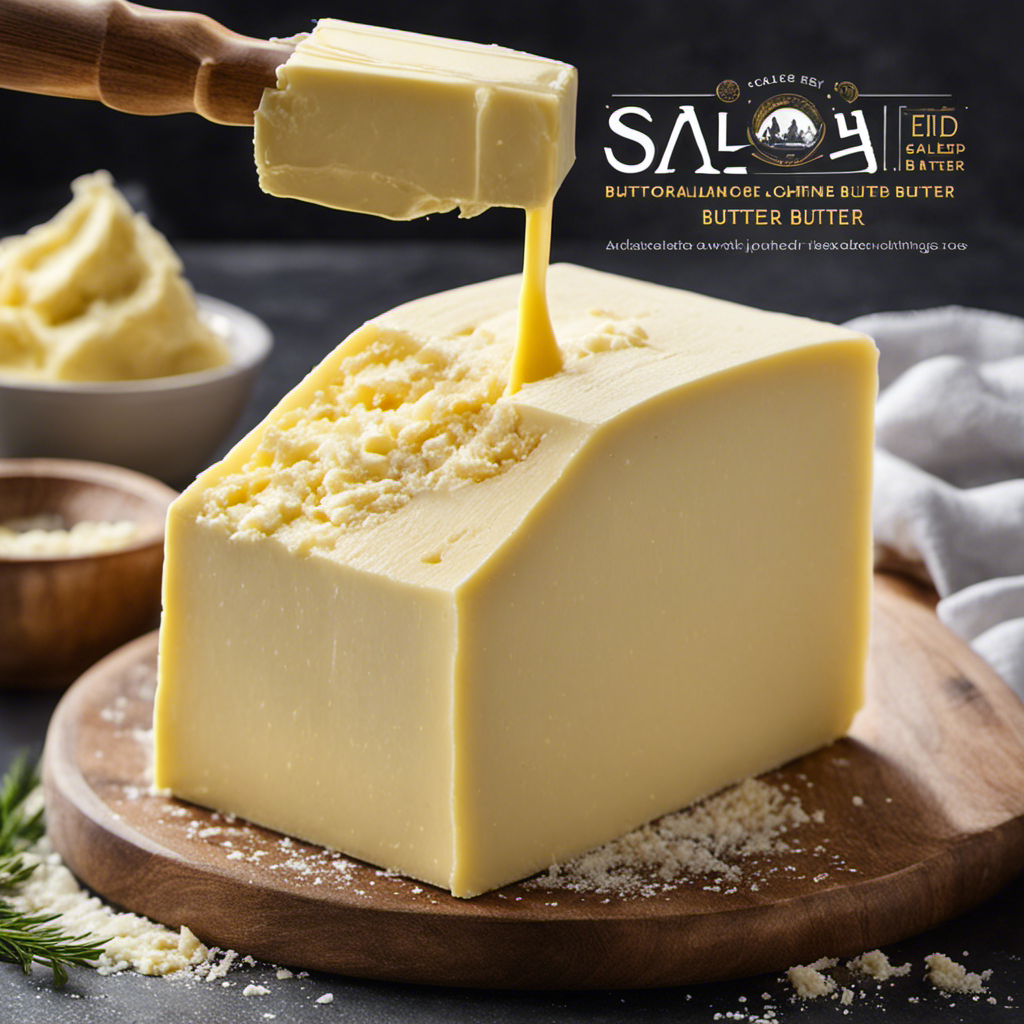I really enjoy treating myself to a crunchy, buttery snack, and frying ramen noodles with butter is the ultimate culinary pleasure.
In this article, I will guide you through the simple yet satisfying process of creating these mouthwatering noodles. We’ll start by selecting the perfect type of ramen noodles and preparing the butter for frying.
Then, I’ll show you how to expertly break apart the noodles and heat them in a skillet with the rich, creamy butter.
Get ready to elevate your ramen game and experience pure bliss with every bite.
Key Takeaways
- Consider the thickness and texture of the noodles when choosing the right type of ramen noodles.
- Melt butter in a frying pan for a rich and savory flavor when preparing the butter for frying.
- Master noodle separation techniques to prevent clumping and achieve the perfect crispy texture.
- Heat the pan to medium-high temperature before adding noodles and spread them evenly for even cooking and frying.
Choosing the Right Type of Ramen Noodles
When choosing the right type of ramen noodles, it’s important to consider the thickness and texture.
There are different types of ramen noodles available in the market, each offering a unique culinary experience.
Thin noodles are delicate and cook quickly, perfect for those who prefer a lighter texture.
On the other hand, thick noodles have a chewy and substantial bite, ideal for those who enjoy a heartier ramen experience.
The cooking time also varies depending on the type of noodles you choose.
Thin noodles typically cook in just a few minutes, while thick noodles may require a slightly longer cooking time to achieve the desired tenderness.
Ultimately, the choice of ramen noodles comes down to personal preference and the type of dish you wish to create.
Preparing the Butter for Frying
To get started, you’ll want to melt some butter in a frying pan. The butter adds a rich and savory flavor to the ramen noodles, making them even more delicious. As the butter melts, it starts to sizzle and bubble, creating a tantalizing aroma that fills the kitchen.
Once the butter is melted, it’s time to break apart the noodles. There are a few techniques you can use to achieve the perfect noodle separation. You can gently pull the noodles apart with your fingers, or you can use a fork to separate them. Another option is to give the noodles a quick stir with a pair of chopsticks, allowing them to separate naturally.
Breaking apart the noodles is an important step because it allows the butter to coat each strand evenly, ensuring that every bite is packed with flavor. So take your time and make sure to separate the noodles thoroughly before adding them to the pan.
Breaking Apart the Ramen Noodles
When it comes to frying ramen noodles, there are a few key points to consider for achieving the perfect crispy texture.
First, mastering noodle separation techniques is essential to ensure that each strand fries evenly and doesn’t clump together.
Additionally, I’ll share some tips for achieving even frying throughout the noodles, so you don’t end up with some parts burnt and others undercooked.
Noodle Separation Techniques
Once you’ve added the butter to the frying pan, you’ll want to gently toss the noodles to encourage separation and prevent clumping. This step is crucial in achieving perfectly fried ramen noodles.
As the butter melts and coats the noodles, they begin to release their irresistible aroma. The sound of the sizzling noodles fills the air, heightening the anticipation of the delicious meal to come.
The noodles start to turn golden brown, developing a crispy texture that contrasts beautifully with their tender centers. The flavors intensify with each toss, as the butter coats every strand, creating a rich and savory taste.
To enhance the experience, consider experimenting with different noodle flavoring techniques and adding additional toppings such as green onions, sesame seeds, or a perfectly poached egg.
It’s time to indulge in this mouthwatering dish!
Tips for Even Frying
For even frying, it is crucial to heat the pan to a medium-high temperature before adding the noodles. This step ensures that the fried noodles achieve the perfect golden brown color. Once the pan is hot enough, add a tablespoon of butter and let it melt. Carefully place the noodles in the pan, spreading them out evenly for even cooking. Use a spatula to gently toss and flip the noodles every few minutes, preventing any burnt or undercooked spots. As the noodles start to turn golden brown, they are ready to be removed from the pan. Serve immediately for a delicious and crispy treat.
Enhancing Noodle Crispiness
To enhance the crispiness of your fried noodles, try using a combination of oil and seasoning. This technique will not only add flavor but also give your noodles a satisfying crunch. Here are some tips to help you achieve that perfect crispy texture:
-
Choose the right oil: Opt for oils with high smoke points, such as vegetable or peanut oil. These oils can withstand high temperatures without burning, ensuring that your noodles crisp up evenly.
-
Season generously: Don’t be afraid to season your noodles with your favorite spices and herbs. Experiment with different combinations to create unique flavor profiles.
-
Use the correct frying technique: Whether you’re deep-frying or stir-frying, make sure to cook the noodles in small batches. This allows for better heat distribution and ensures that each strand of noodle gets evenly coated in oil and seasoning.
-
Control the heat: Maintain a consistent cooking temperature throughout the frying process. Too high of heat can cause the noodles to burn, while too low of heat can result in soggy noodles. Adjust the heat as needed to achieve that perfect crispy texture.
Heating the Butter in a Skillet
When it comes to heating butter in a skillet, there are a few important factors to consider.
First, you need to be aware of the smoke point of butter, which is the temperature at which it starts to burn and release smoke. This is important because if you heat the butter beyond its smoke point, it can result in a burnt flavor and potentially harmful compounds.
Secondly, achieving an even distribution of heat is essential for cooking with butter. In order to ensure that the butter melts and heats evenly, it is important to use low to medium heat and allow the butter to melt slowly.
Lastly, if you’re looking for alternative cooking methods, you might consider using ghee or clarified butter, which have higher smoke points and can withstand higher temperatures without burning.
Smoke Point of Butter
Make sure you don’t heat the butter too high because it has a lower smoke point than other oils. When butter reaches its smoke point, it starts to break down, releasing a burnt aroma and flavor.
To avoid this, it’s important to keep the heat at a moderate level when using butter for frying. If you’re looking for alternatives to butter with a higher smoke point, consider using oils such as canola, vegetable, or avocado oil. These oils have a higher tolerance for heat and won’t burn as easily.
However, if you prefer the rich flavor that butter brings to your dishes, you can still use it for frying as long as you monitor the heat and prevent it from reaching its smoke point.
Even Distribution of Heat
The key to ensuring an even distribution of heat is to use a pan with good conductivity, like stainless steel or cast iron.
When it comes to noodle frying techniques, achieving a crispy texture is the ultimate goal. To achieve this, it’s important to start with a hot pan and evenly distribute the noodles in a single layer. This allows the noodles to crisp up evenly, without any soggy spots.
Additionally, using a generous amount of oil or butter helps to promote browning and enhance the crispy texture. It’s also crucial to resist the urge to stir too often, as this can disrupt the cooking process and prevent the noodles from achieving that desired crunch.
Alternative Cooking Methods
If you’re looking to try something different, you can experiment with alternative cooking methods for achieving crispy fried noodles. Here are a few creative ramen noodle recipes that will surely tantalize your taste buds:
-
Stir-Fry: Sauté the noodles with colorful vegetables and your favorite protein for a quick and flavorful meal.
-
Baking: Toss the noodles with butter and bake them in the oven until golden brown for a crunchy and delicious snack.
-
Air-Frying: Coat the noodles with a little oil and air-fry them until crispy for a healthier twist on fried noodles.
-
Deep-Frying: Heat up a pot of oil and fry the noodles until they turn golden and crispy, perfect for topping off soups or salads.
These alternative cooking methods allow you to explore different textures and flavors, elevating the humble ramen noodle into a culinary masterpiece.
Adding the Ramen Noodles to the Skillet
Once the butter has melted in the skillet, you’ll want to add the ramen noodles. This is where the magic happens – transforming plain noodles into a crispy, flavorful delight.
To achieve optimal crispiness, it’s crucial to master the art of noodle flipping. As the noodles sizzle in the butter, use a spatula to carefully flip them over, ensuring that each strand gets evenly coated in the buttery goodness.
This flipping motion allows the noodles to brown on both sides, creating a satisfying crunch that adds texture to your dish. The key is to be gentle yet swift, using your wrist to flip the noodles with finesse.
Practice makes perfect, and with time, you’ll become a master of noodle flipping, achieving that irresistible crispiness every time.
Stirring and Flipping the Noodles for Even Frying
As you stir and flip, you’ll notice the noodles browning evenly on both sides, giving them that satisfying crunch you crave. Achieving that golden brown color requires a few key stirring techniques. Here’s how to do it:
- Gently toss the noodles in the skillet using a pair of tongs. This helps to distribute the heat evenly and prevent them from sticking together.
- Use quick and continuous stirring motions to ensure all sides of the noodles are exposed to the heat. This will help them brown evenly and avoid any burnt spots.
- Flip the noodles occasionally to ensure even cooking and to prevent them from becoming too crispy on one side.
- Adjust the heat as needed to maintain a steady golden brown color.
Seasoning the Fried Ramen Noodles
Now that we have mastered the art of frying ramen noodles with butter, let’s move on to the exciting part: seasoning the fried noodles.
The options for noodle seasoning are endless, and you can get creative with different flavoring alternatives to suit your taste preferences.
One classic choice is to use the seasoning packet that comes with the ramen noodles. This will give your fried noodles that familiar and comforting taste.
However, if you’re feeling adventurous, you can try other seasonings like soy sauce, garlic powder, or chili flakes to add a kick of flavor.
Don’t be afraid to experiment and find the perfect combination that satisfies your cravings.
Serving and Enjoying the Crispy Ramen Noodles With Butter
To fully enjoy the crispy noodles, sprinkle a dash of salt and a squeeze of lime over your creation. As you take your first bite, the buttery flavor coats your taste buds, leaving a rich and savory sensation.
Here are some serving suggestions to enhance your experience:
- Top the fried ramen noodles with a sunny-side-up egg for a creamy and protein-packed addition.
- Add some sliced spring onions for a refreshing and aromatic twist.
- For a spicy kick, drizzle some Sriracha sauce over the noodles.
- To add a crunchy element, sprinkle some crushed peanuts or sesame seeds on top.
But if you’re looking for butter alternatives, you can try using olive oil or coconut oil instead. These alternatives will provide a different flavor profile while still giving your fried ramen noodles a delightful crispiness.
Frequently Asked Questions
What Are Some Alternative Methods for Cooking Ramen Noodles With Butter?
There are various alternative methods to cook ramen noodles with butter. You can experiment with different flavors like soy sauce or chili flakes. Get creative with serving options, like adding vegetables or protein for a complete meal.
Can I Use Any Type of Butter for Frying Ramen Noodles?
Yes, any type of butter can be used for frying ramen noodles. However, using flavored butter like garlic or herb-infused butter can add extra deliciousness. As for seasoning, options like soy sauce, sriracha, or sesame oil work best.
How Long Does It Take for the Butter to Melt in the Skillet?
To prevent butter from burning while melting in the skillet, it’s important to use low heat and constantly stir. This will ensure that the butter melts slowly and evenly, achieving the perfect buttery flavor in fried ramen noodles.
Can I Add Vegetables or Other Ingredients to the Fried Ramen Noodles With Butter?
Yes, you can definitely add vegetables or other ingredients to enhance the flavor of fried ramen noodles with butter. It’s a great way to make the dish more nutritious and delicious.
How Can I Store Leftover Fried Ramen Noodles With Butter?
To store leftover fried ramen noodles, place them in an airtight container and refrigerate. When reheating, add a splash of water or broth to prevent them from drying out. Enjoy the deliciousness again!
Conclusion
As I take a final bite of the crispy ramen noodles with butter, I am filled with a sense of satisfaction and contentment.
The rich flavors of the butter blend perfectly with the crunchy texture of the fried noodles, creating a symphony of taste in every bite.
This simple yet delightful dish symbolizes the beauty of experimentation and creativity in the kitchen.
By taking something as ordinary as ramen noodles and transforming them into a delectable masterpiece, I have discovered a new and exciting way to enjoy this beloved comfort food.
